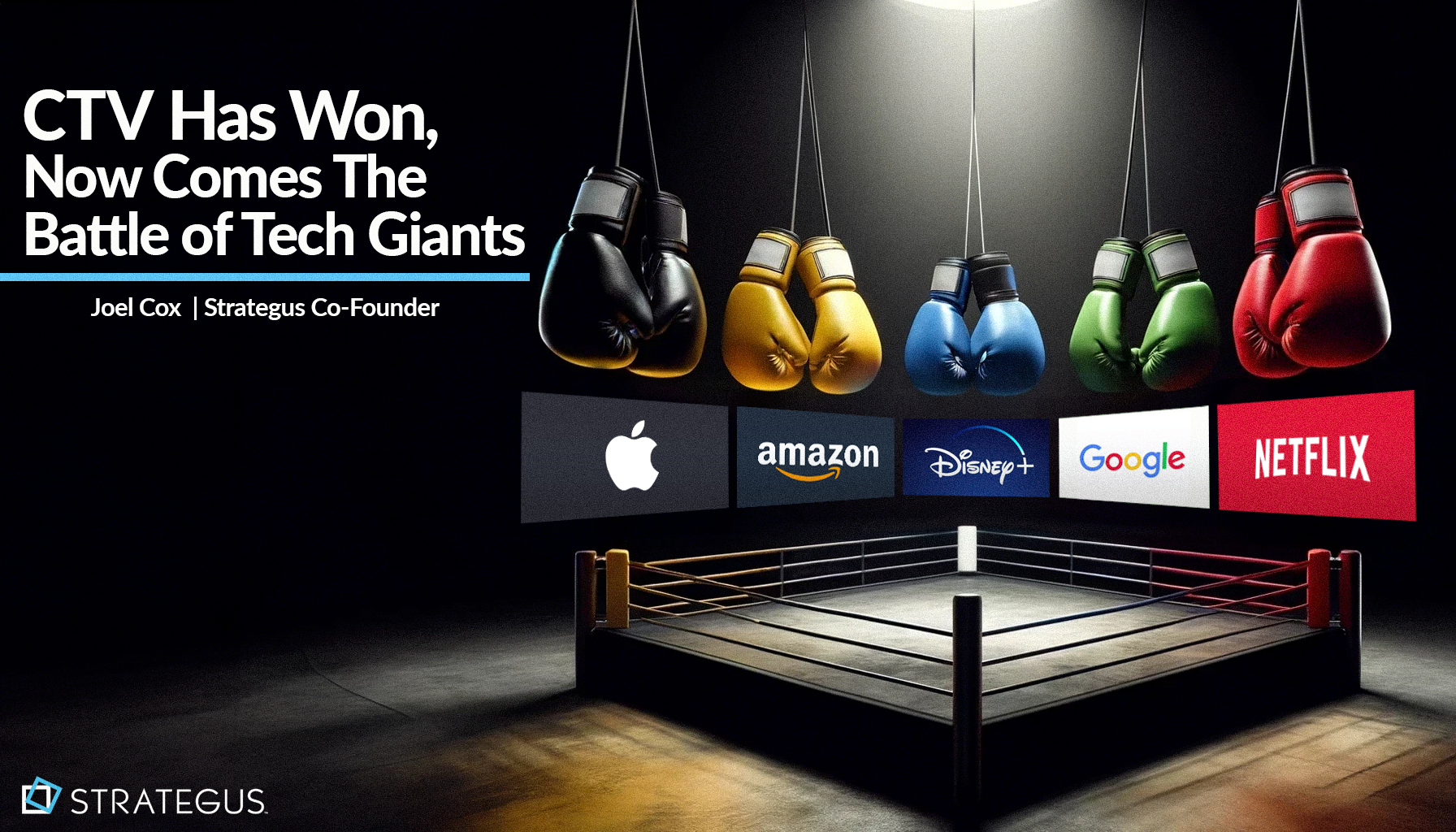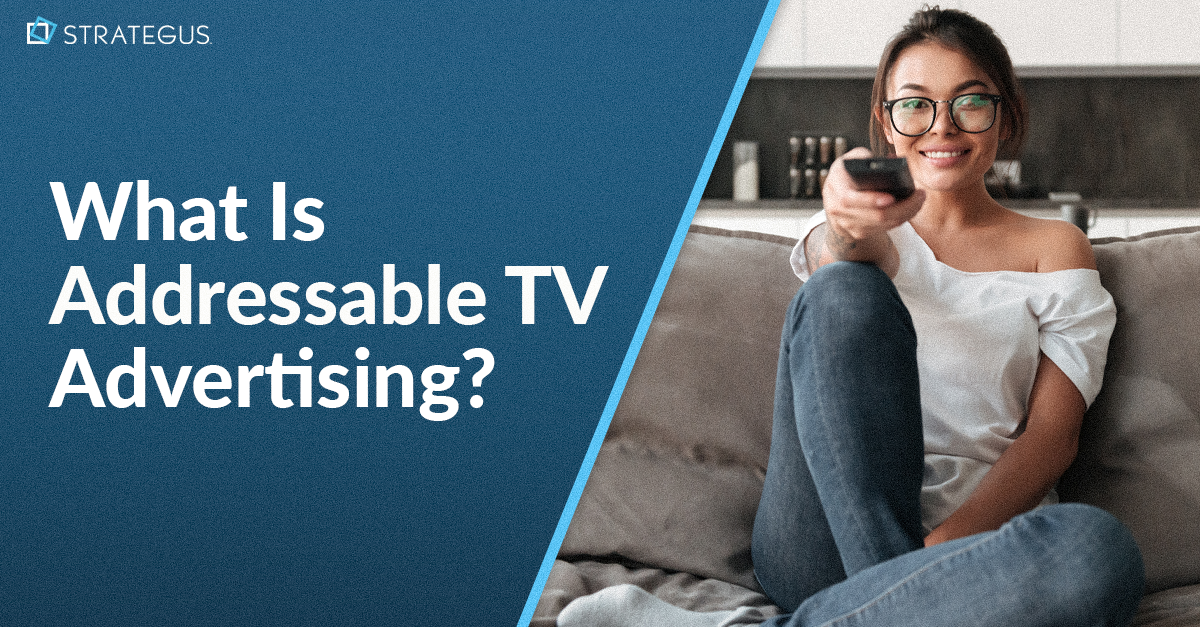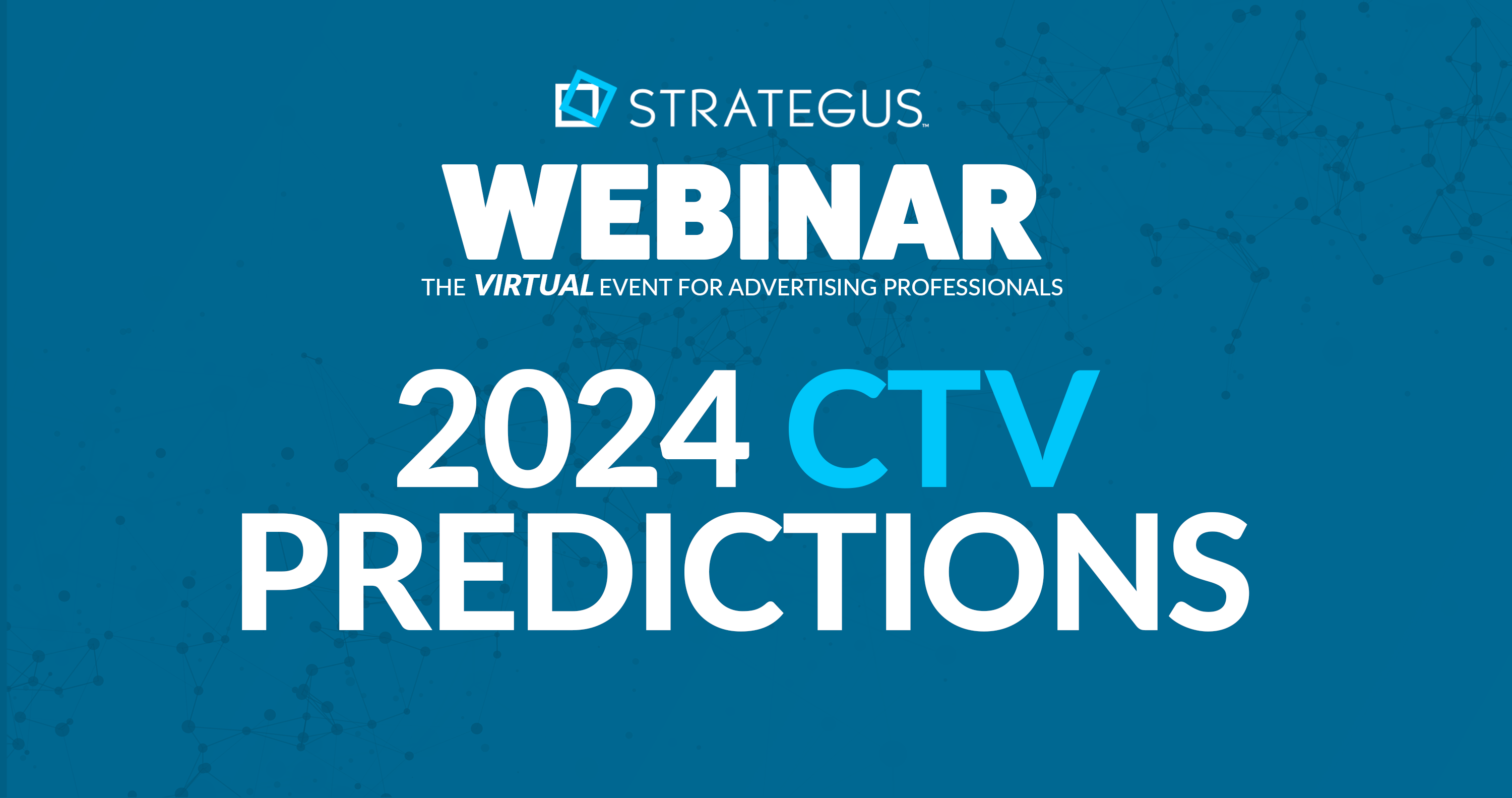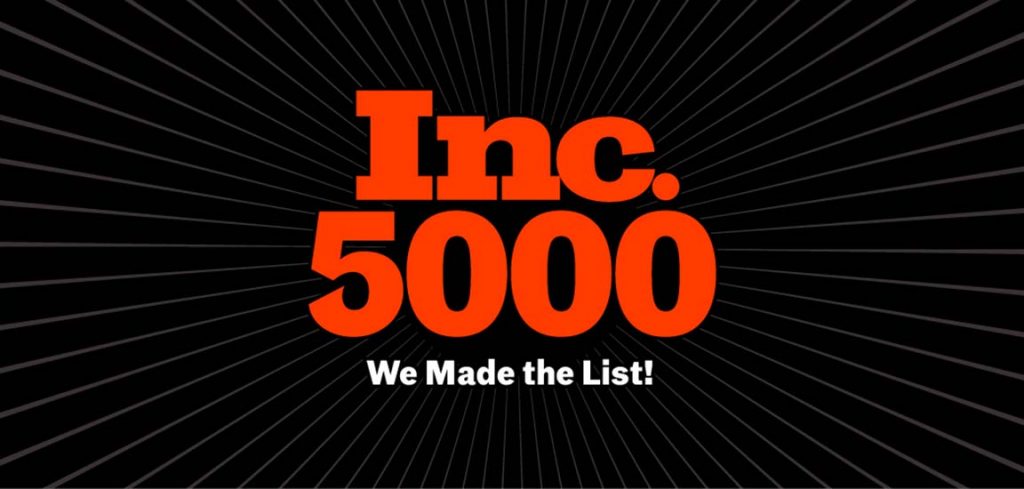- Home
- Strategus Blog
- Connected Television (CTV) Advertising — The Comprehensive Guide
Connected Television (CTV) Advertising — The Comprehensive Guide
 Andy Dixon
Andy Dixon
15 minutes read
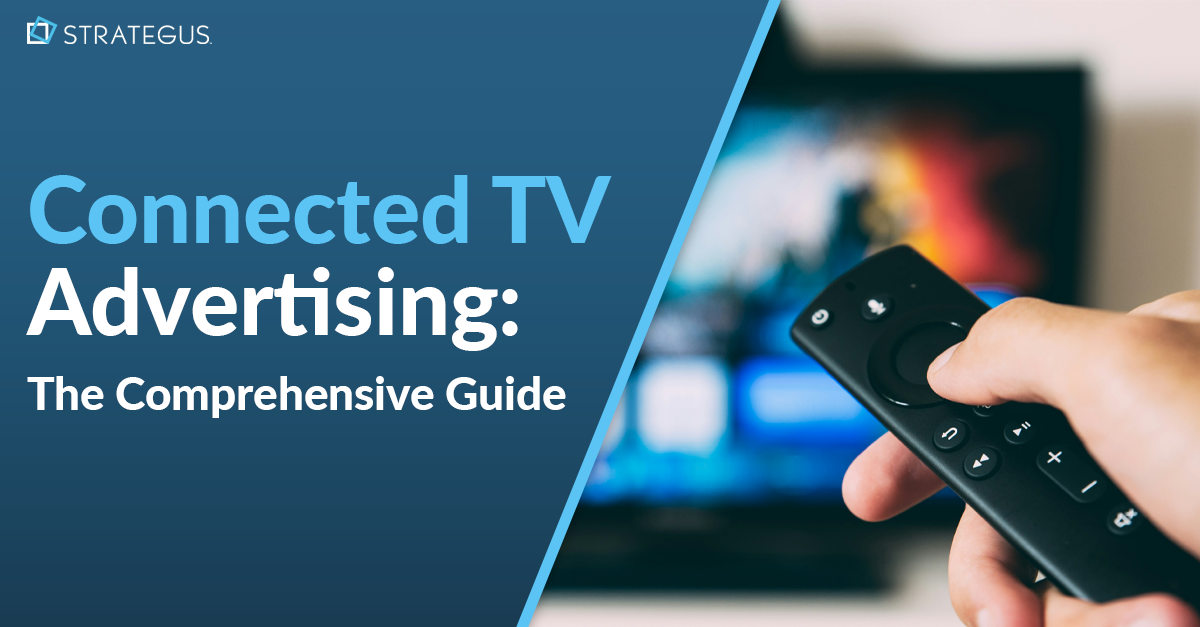
In 2018, marketers and media buyers were in awe at the rate of Connected Television advertising growth. While terms like CTV and “over-the-top” (OTT) were still in their infancy, the pace of adoption in the industry was astonishing, as ad spend increased as much as 10x in just one quarter.
Hailed as the thing to reshape advertising, CTV hit the scene with a splash just a few short years ago. When stay-at-home orders were enforced earlier this year as a result of the COVID-19 pandemic, they served as a catalyst and accelerant for hyper-growth in CTV as millions of people were relegated to their homes, with only their TV and the internet for entertainment.
With the rapid evolution that this space is experiencing, there is a lot to keep track of, regardless of your role in advertising and media buying. Unless you are actively educating yourself on the latest trends, technology, and news in this area, it can be an overwhelming task to stay up to date. For that reason, our team has put together a comprehensive guide on everything you need to know about CTV / Connected TV advertising… for now.
Connected TV Vs. OTT Advertising — What’s The Difference?
CTV and OTT are terms that are frequently used interchangeably and confused for one another. In fact, there are many marketers that falsely presume CTV and OTT advertising are competitive with one another. This is a common misconception.
The Difference
The term OTT is used in reference to any video content that is accessed over the internet as opposed to traditional cable, broadcast, or satellite television providers. This means streaming, usually via platforms such as Hulu, Prime Video, Sling TV, and so forth, can occur on any device that can access the internet including mobile devices, PCs and laptops, gaming consoles, and televisions.
This makes CTV a subset of OTT since the term is used in reference to televisions connected to the internet, whether it is through the smart TV’s own operating system or through a streaming stick such as Amazon Firestick or Xbox.
Advantages & Limitations
In most cases, OTT advertisements cannot be skipped, which allows for a much higher video ad completion rate. Not to mention OTT/CTV advertising allows for more sophisticated audience targeting and the ability to tailor different ads to different audience segments. In comparison to cable services that allow viewers to fast forward through commercials via DVR and limited targeting capabilities, OTT advertising is far more attractive to marketers. Advertisers and marketers will love the depth and breadth of reporting metrics that CTV gives as compared to traditional TV too.
That’s not to say OTT is not without its downsides. The biggest limitation at the moment is the navigating strategy. With so many platforms to choose from, there is a higher chance of audience overlap, making attributions and conversion tracking difficult…
>>Read our full post on CTV Vs. OTT advertising here
Understanding The OTT/CTV Devices Ecosystem In Advertising
So you have a high-level grasp of OTT. But what does it really encompass from a device perspective? After all, the internet is widespread and there are countless devices and portals where content can be accessed. Where do you advertise and which devices are the best to target?
Device Categories
At Strategus, we consider the following the 3 most prominent device categories for OTT advertising:
- CTV/Connected TV Devices – This is by far the most premium of all device categories. The bulk of long form content is viewed on smart TVs, not to mention it is the largest viewport in the household, allowing for optimal video ad impact.
- Browser-Based Devices – This is in reference to websites where full length episodic content – FEP (30-60 minutes) can be viewed on a laptop or PC. Think full episodes of House Hunters on HGTV.com – the same content as what you’d see on your CTV device, but browser-based.
- Tablet/Mobile Devices – Similar to browser-based devices, many streaming services also have apps that can be accessed through tablets and mobile devices. Not surprisingly, this is one of the largest device categories in terms of where and how people access the internet. However, it is important to remember that this is also the least optimum in terms of screen size and view engagement.
>>Learn more about this in detail, read our full post on the device ecosystem for OTT/CTV here.
Can CTV Advertising Drive Leads?
Since the introduction of OTT/CTV, the number of cord-cutters making the switch from traditional TV to digital services has been steadily rising. As marketers shift ad budgets and place a higher focus on OTT and CTV campaigns, the question becomes: How can CTV advertising be more than an awareness campaign? Can it drive leads?
The Challenge
Perhaps one of the most attractive things about CTV advertising is that ads are generally non skippable, which paves way for nearly 100% video completion rates. The downside is they are also not actionable or clickable. And unfortunately, serving ads programmatically is not enough to guarantee leads.
The Best Practices
The good news about addressing the challenge in CTV advertising is that the tools and the approach already exist. There are so many data points at our fingertips that allow any advertiser to get creative with lead generation.
- Optimize audience targeting – Instead of casting a wide net, refine the audience down to a core persona well beyond just demographics. You can target based on age, location, gender filters, focus on behavior, personality traits, shopping habits, and more.
- Blend with other channels – Leverage other channels to drive home a campaign message. Retarget individuals that finish watching a video ad to completion with clickable call-to-action on their phones, tablets, and computers. You can learn more about how this works in this post.
- Reporting and attribution performance – Accurately track and attribute sales from each campaign to properly determine ROI. Strategus’ Attribution Suite allows for both various forms of online and offline attribution, answering the question: who saw your ad, and what did they do after?
>>Read the full-length article on how to drive leads via CTV advertising
Connected TV Advertising Campaign Best Practices
With how quickly the industry is evolving, we are often asked whether there are “rules of thumb” to follow in order to achieve the best results with CTV advertising campaigns. While our team has never believed in a one-size-fits-all approach, there are several high-level best practices that can be utilized to maximize success.
- Leverage a blended approach to ensure the messaging is heard
- CTV + Retargeting: retargeting allows for resonance and recollection to increase overall, increasing the chances of a consumer taking action
- CTV + Programmatic Display: viewing the same ad, or seeing the same brand across different mediums will make a brand much more memorable
- CTV + Paid Search: sponsored content, strategically placed promotions, and discounts can be the final push needed for a consumer to purchase
- CTV + All of the Above: every campaign is different and needs a different strategy; get creative
- CTV + Retargeting: retargeting allows for resonance and recollection to increase overall, increasing the chances of a consumer taking action
- Use timing and pacing to optimize ad budget
- Timing: Is the video ad that is playing relevant at the time it is being shown? In other words, running an ad for a breakfast burrito in the late afternoon might not make the most sense.
- Pacing: How are you allocating your budget? Pacing should be monitored so the campaign serves smoothly and evenly throughout the flight, rather than the entire month’s budget being used up in the first few days of a new campaign.
- Timing: Is the video ad that is playing relevant at the time it is being shown? In other words, running an ad for a breakfast burrito in the late afternoon might not make the most sense.
- Lookalike audiences and hyper-local targeting
- Lookalike Audiences: If you have success with one cohort, it is a big loss not to use that data on similar audiences. When you succeed, replicate it!
- Hyperlocal Targeting: It would be a waste not to leverage real-time, smartphone GPS-derived, data when working with a physical location. Target individuals who are within the vicinity of the store!
>>Read about CTV campaign best practices in detail here
CTV vs. OTT: Differences In Advertising Strategy
There are fundamental advantages to CTV, but there are some limitations that require adjustments in advertising strategy when compared to the rest of the OTT advertising eco-system.
In general, CTV advertising carries the following advantages and limitations:
- CTV ads are non-skippable – This means that your campaign will have much higher view rates, but also is at risk of being physically disengaged with, IE leaving the room.
- CTV by nature has a premium audience base – The audience here is deeper down your marketing funnel and thus, omnipresence achieved via blended retargeting becomes the main driver behind campaign efficiency.
- CTV ads are not clickable – This forces advertisers to focus heavier on brand-development and influence-building over direct lead generation. For branding messages to be the most efficient, tailored content must be delivered to the proper target audience repeatedly for reinforcement.
In order to adjust for these differences from CTV, your advertising strategy should shift in the following ways:
Use a blended approach with CTV – By combining CTV advertising with other advertising channels you can ensure that the premium experience of CTV can be made actionable.
- CTV/OTT + Retargeting Combination: Made possible with our Encore Omnichannel technology, you can immediately follow-up with a likely prospect who has viewed a CTV ad in full with banner and/or scroll ads and move them through the funnel with powerful sequential messaging.
- CTV/OTT + Paid Search Combination: sponsored content and keywords increase your visibility among viewers who have already displayed an interest in your service/product. Paid search campaigns often serve as the final push that moves a viewer from the awareness to consideration.
- CTV/OTT + Programmatic Display Combination: Viewing the same ad, or seeing the same brand across different mediums will make a brand much more memorable
>>Read more about CTV VS: OTT advertising strategy differences in detail here
Examples Of CTV Audience Hyper-targeting
One of the biggest missteps when approaching CTV advertising is the underutilization of big data. This is a huge distinguishing value proposition that hasn’t been available in the past with traditional TV. Not taking advantage of it is a rookie mistake.
We illustrate below just how many different ways there are to hyper-target an audience:
- Behavioral Targeting: This is the ability to target individuals based on habits, online personality, lifestyle, interests, and more.
- Demographic Targeting: This is the ability to refine a demographic by any data point you can imagine, from ethnicity, education level, hometown, relationship status, income, and more.
- Contextual Targeting: This is the ability to place ads for specific products or services within the context of what the viewer is watching. Take for example, an ad for new cookware in between episodes of an at-home cooking show.
- Time-of-Day Targeting: This is the capacity to run the same ad to different people at different times, based on their viewing behavior.
- Technographic Targeting: This is the ability to target devices based on technical specs such as browser, operating system, connection speed, etc. Filter out the audiences where the ad will run into playback issues and watch the effectiveness go up dramatically.
- Geographic Targeting: This is the ability to pinpoint where an ideal customer is, in real-time, where they have visited recently, or frequently and only market to them when we want to based on those inputs.
>>Learn more about audience hyper-targeting in detail here
CTV Cross-Device Tracking And Targeting
Because CTV is not inherently actionable as we discussed above, it is extremely important to be able to track and target your audience on their other devices to be able to drive actions and make CTV ads attributable.
There are two main ways you can cross-device track:
1: Probabilistic Data
Probabilistic data utilizes different anonymous data points that range from page visits to the time of day to what operating system a person is using. This method is easily scalable and much more complex.
2: Deterministic Data
Deterministic data is collected based on login information for IDs, websites, and apps that link different devices. How many places does a person log in to Sling, Hulu, Gmail, Netflix, Spotify, etc.?
>>Learn more about what you can do with cross-device tracking and targeting in detail here
Why Connected TV Is The Premium OTT Option
Knowing that there are so many OTT options available, it’s important to stress why Connected TV reigns supreme over all other inventory. These are the biggest reasons why Strategus favors CTV over any other device category:
1. Premium Content & Less Potential For Brand Safety
Content on CTV streaming services like Crackle, Sling, Tubi, etc. are of higher quality with more variance in comparison to user generated content. This is one of the reasons why so many people are switching from traditional to digital in the first place.
Because the quality of the content on CTV is so much higher, there is substantially less risk of a brand’s ad campaign showing up in an undesired location. This is an issue that would be more prevalent on browser ads on Facebook or YouTube, for example.
2. Non-Skippable Ads & Engaged Audiences
Ads are not skippable on CTV devices which allows for higher video completion rate (near 100% across the board for CTV campaigns). Additionally, since the viewer is in the midst of a long-form show or movie that they are already engaged with, there is a statistically higher chance that they will also pay more attention to the video ad that is playing.
3. Screen Size & Impressions
There is simply a huge advantage to running a video campaign on the largest digital device in the household. The impact is higher and the effect can’t be replicated on other OTT devices. Not to mention, impressions are easier to guarantee on CTV and the risk of fraud from things like impersonator bots is much lower.
>>Read more about the premium nature of CTV in detail here
How To Avoid CTV Fraud As An Advertiser Today
Ad fraud is not a new topic. It is one of the biggest concerns for most marketers and media buyers in the industry. While CTV reduces the risk of ad fraud, it still exists and it is important to know what to look out for, so you can avoid it in your campaigns.
Types of Fraud in CTV Advertising
- Impersonator Bots – This is one of the more common fraud tactics we see. These ad fraud bots impersonate unique users in order to falsify thousands of ad interactions.
- App Fraud – Similar to impersonator bots, this leverages an app that may pose a different function on the front end, but secretly make ad requests without the user’s knowledge.
- Device Fraud – This is the case where malicious software is installed and once it is on the device, the scammers can make phone interactions to drive revenue to specific ads.
How to Stay Protected
- Location Verification: A simple trick is to monitor the location of the ad interactions. This will help identify suspicious behavior.
- Third Party Tracking & Ad Verification: Utilize third party validation, monitoring and tracking like White Ops, Device Atlas and DoubleVerify to ensure that ads are being displayed where they say they are.
>>Read our full post on how to avoid/approach CTV ad fraud here
Where Is Connected TV Advertising Going To Be In 10 Years?
With how much progress and innovation CTV has brought to the advertising world in just a few short years, it’s exciting to think about what the future holds for this industry. After analyzing the various trends and technological advances, these are the top predictions Strategus has:
- CTV / Mobile Devices will be paired to have “clickable” ads. With mobile phones often serving as a remote for CTV devices, we anticipate that Bluetooth and wifi cross-device connection will serve as the vehicle to making ads actionable.
- Eye-tracking and facial recognition software will be leveraged to further refine success metrics such as viewer engagement. Are they actually watching the ad?
- Voice recognition and voice command will be factored in as an engagement action. For example, using Alexa or Siri to “save” a product.
- Wearables will be leveraged to retarget ads based on real-time user location and emotional state.
- Mainstream events like the NBA Finals or the World Cup will move from traditional television giants over to a streaming service.
>>Read more about our CTV advertising future predictions here
>>Between CTV and Linear TV, which one is better?
The Bottom Line
CTV is new, exciting and constantly evolving in the world of advertising. The technology and the data have expanded an advertiser’s ability to really get creative for their clients. Strategus is thrilled to be a pioneer in the industry, at the forefront of this exciting new space. Contact us to hear more about our thoughts or consult our experts on your next CTV campaign.

Andy Dixon is a seasoned Content Writing Specialist at Strategus, renowned for his expertise in creating engaging and impactful digital content. With over a decade of experience in content creation, Andy has honed his skills in a variety of niches, ranging from technology and marketing to education.
Strategus is a managed services connected TV(CTV) advertising agency with over 60,000+ campaigns delivered. Find out how our experts can extend your team and drive the result that matter most.
Talk to an Expert
Table of Contents
- Connected TV Vs. OTT Advertising — What’s The Difference?
- OTT/CTV Devices Ecosystem In Advertising
- Can CTV Advertising Drive Leads?
- CTV Campaign Best Practices
- CTV vs. OTT: Differences In Advertising Strategy
- Audience Hyper-targeting
- CTV Cross-Device Tracking
- Why Connected TV Is The Premium OTT Option
- How To Avoid CTV Fraud As An Advertiser Today
- Connected TV Advertising In The Future
Seeking a Custom CTV Strategy That Delivers?
What to read next
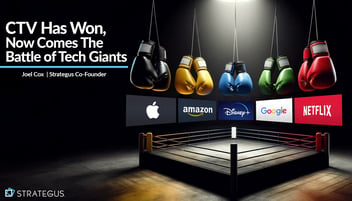
CTV Has Won, Now Comes the Battle of the Tech Giants
Who will be the winner with Amazon, Netflix, Google, Apple, and Disney battling for CTV supremacy? Just a few years ago, a phenomenon called...
6 minutes read

What Is Addressable TV Advertising and How Does It Work
In the early days of TV, ads were placed based on the programs they supported. This means that every household tuning into a given broadcast would...
7 minutes read

10 OTT Trends Shaping CTV Advertising in 2024
In the 17 years since Netflix launched its streaming service, over-the-top (OTT) media has become standard. What started as a novel concept now...
15 minutes read

What Is an Ad Exchange and How Does It Work
Before ad exchanges, media inventory was exclusively purchased through direct negotiations with publishers. This worked fine in the early days. But...
8 minutes read



